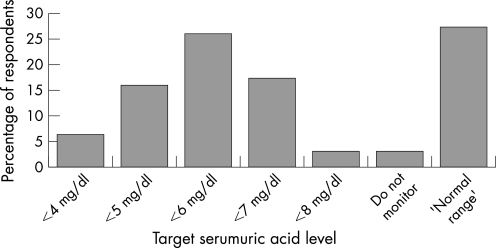The pathogenesis of urate crystal deposition is reasonably well understood, and with appropriate urate‐lowering therapy (ULT) and lifestyle advice, the objective of management is cure. Nonetheless, many patients with gout continue to experience frequent and recurrent episodes of gout and progression of their disease. This is because the condition is often misdiagnosed, or diagnosed late, and treatment is frequently suboptimal.1,2 These concerns led to the development of evidence‐based recommendations relating to the diagnosis and management of gout by a task force from the European League Against Rheumatism (EULAR). The EULAR recommendations were developed using a combination of research‐based evidence and expert consensus, and provide a valuable resource for physicians.1,2
The current diagnosis and management of gout was investigated in a survey conducted among delegates attending EULAR 2006. Delegates visiting the commercial stands were invited to complete a written questionnaire of 12 questions designed to evaluate awareness of the impact of gout, the goals of treatment, and patterns of clinical practice. A total of 741 respondents (6.7% of attendees), predominantly rheumatologists from Europe, completed the questionnaire.
The results indicate a good level of understanding concerning gout and its management, but also highlight some marked variations in clinical practice.
Respondents reported using both the measurement of serum uric acid (sUA) (97%) and the examination of synovial fluid (91%) to confirm suspected gout. Only 15% said they would prescribe ULT when the diagnosis of gout was made, most reported that they would usually wait for the next gout attack (24%) or for at least two further attacks (32%) to occur before initiating treatment. Whereas 29% said they would initiate ULT during an attack, the remainder confirmed they would wait until after an attack, and most (60%) would then begin therapy within 2 weeks. Sixteen per cent of respondents would treat asymptomatic hyperuricaemia with ULT, with a marked difference in practice being observed between rheumatologists and internal medicine specialists (15% versus 59%, respectively). Importantly, opinions varied considerably on what sUA level might be regarded as representing adequate control in a gout patient (fig 1).
Figure 1 Discordance between doctors concerning the level of serumuric acid that is thought to inflect aduquete controlf of gout.
It is interesting to consider some of these findings in light of the recent EULAR recommendations. These make clear, for example, that sUA levels do not confirm or exclude a diagnosis of gout. Despite this, nearly all respondents (97%) stated that they would rely on measuring sUA for precisely that purpose. For gout management the recommendations assign a central role to sUA and define the therapeutic goal of ULT as being to promote crystal dissolution, prevent crystal formation and improve clinical symptoms by maintaining sUA below 6 mg/dl. The survey findings show, however, that most physicians perceive a reduction in the frequency of acute attacks as the central goal of therapy and that the ability to cure the condition by maintaining sUA below 6 mg/dl is not yet universally appreciated.
A caveat of any such survey is that physicians may have responded on the basis of what they know should be done rather than what they actually do in practice. They may also have completed the survey in haste and possibly misinterpreted some of the questions. Nevertheless, a large number of practitioners representing several countries in Europe participated in this simple survey.
The authors hope that, as awareness of the EULAR recommendations grows, and the goal of maintaining sUA below 6 mg/dl becomes more widely recognised, all patients with gout will be spared the burden of this eminently treatable condition.
Footnotes
Funding: The study was financed by Ipsen, France, for which the authors are grateful.
References
- 1.Zhang W, Doherty M, Pascual E.et al EULAR evidence based recommendations for gout. Part I: diagnosis. Report of a task force of the EULAR Standing Committee for International Clinical Studies Including Therapeutics (ESCISIT). Ann Rheum Dis 2006651301–1311. [DOI] [PMC free article] [PubMed] [Google Scholar]
- 2.Zhang W, Doherty M, Bardin T.et al EULAR evidence based recommendations for gout. Part II: management. Report of a task force of the EULAR Standing Committee for International Clinical Studies Including Therapeutics (ESCISIT). Ann Rheum Dis 2006651312–1324. [DOI] [PMC free article] [PubMed] [Google Scholar]



